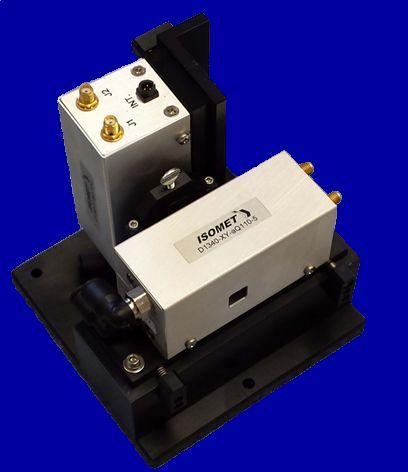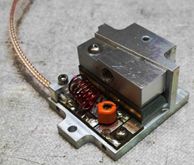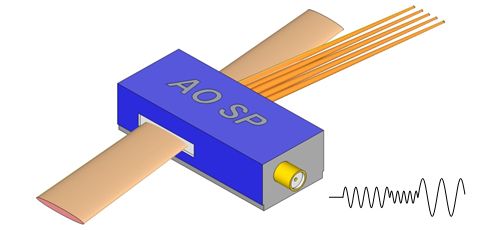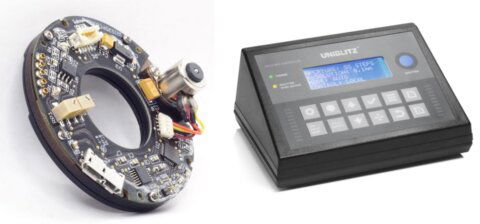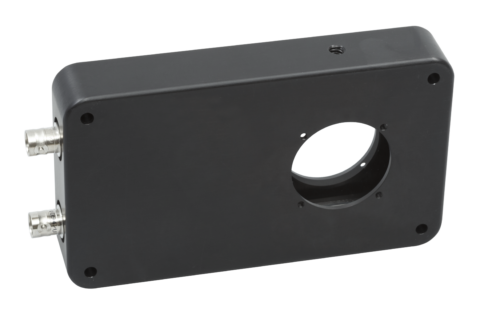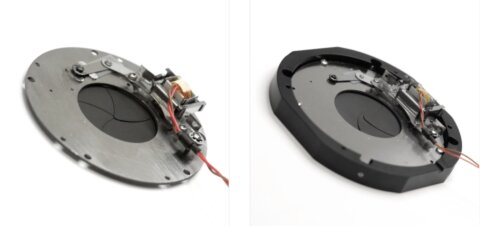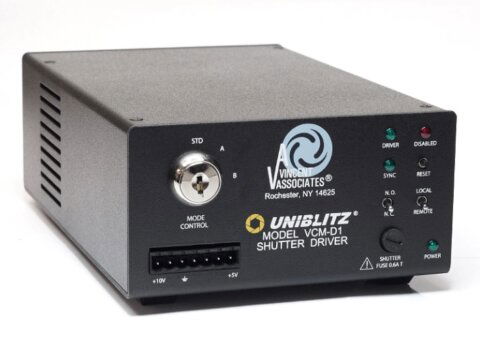Acousto-optic frequency shifters
- Technology
- Acousto-optics
- Partner
- Isomet
Isomet’s acousto-optic frequency shifters (AOFS) are specially designed for use with laser beams. After the AOFS the diffracted laser beam is shifted by the amount of the respective centre frequency of the AOFS. Depending on the law of Bragg angle, the laser frequency is either decreased or increased (down-shifted or up-shifted).
For frequency shifts of a laser beam smaller or larger than the centre frequency of the AOFS, two or more units can be cascaded to achieve a difference or summation of the respective shifts. Corresponding RF drivers are also available.
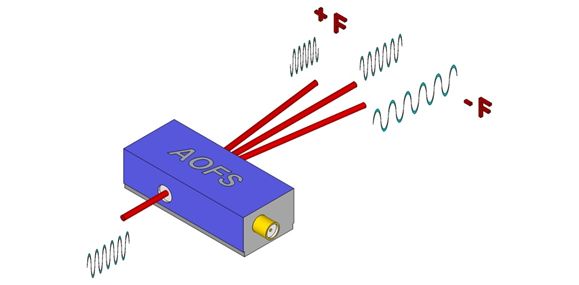
Range features
A high level overview of what this range offers
- Wavelength range: 325nm up to 10,600nm
- Optical materials: PbMoO4, TeO2, Ge, fused silica
- Centre frequencies: ca. 100 – 350MHz
- Tuning bandwidth: 2.5 – 100MHz
- Active apertures: ca. Ø 0.2mm up to 6mm
- Special designs according to customer requirements available
- Suitable RF drivers, synthesisers, and amplifiers
Downloads
for Acousto-optic frequency shifters
What’s in this range?
All the variants in the range and a comparison of what they offer
| Model | Standard A/R [nm] | Material | Active aperture – Ø [mm] | Centre frequency [MHz] | Bandwidth [MHz] |
|---|---|---|---|---|---|
OAM1059-V31 | 633 | TeO2 (S) | 1.5 | ±10 | ± 0.5 |
OAM1059A | 633 | TeO2 (S) | 1.5 | 15 | ± 1 |
FS1303A-T150S-1 | 1550 | TeO2 (S) | 2 | 150 | ± 1 |
OAM1141-TxxS-2 | 400 – 700, 633 – 830 | TeO2 (S) | 2 | 40 / 80 | ± 1 |
M1136A-FS40S-1 | 399 | SiO2 (S) | 1 | 40 | ± 5 |
1205C-1-869 | 633 | PbMoO4 | 0.7 | 80 | ± 15 |
1205-1054 | 633 | PbMoO4 | 1 | 80 | ± 5 |
M1141-P80-1 | 633 | PbMoO4 | 1 | 80 | ± 5 |
1205-1118 | 532, 488 – 633, 633, 633 – 830 | PbMoO4 | 2 | 80 | ± 5 |
M1136B-FS80L-H | 325 – 399 | SiO2 (L) | 1 / 2 / 3 | 80 | ± 5 |
1206C | 442, 488 – 633 | PbMoO4 | 1 | 110 | ± 25 |
1205-1069 | 633 | PbMoO4 | 1 | 160 | ± 5 |
1250C | 442 – 488, 488 – 633 | PbMoO4 | 0.75 | 200 | ± 50 |
1250C-829A | 360 – 420, 442 – 488 | TeO2 | 0.45 | 260 | ± 50 |
OPP-1 | 442 – 850 | PbMoO4 | 1.5 | 300 | ± 100 |
1260C | 360 – 442, 488 – 633, 633 – 830 | TeO2 | 0.2 | 350 | ± 100 |
1209-7-1064M | 10600 | Ge | 6 | 40 | ± 10 |
1210-G(fc)-H-MIR | 2050, 2500 – 5000 | Ge | 2 / 4 | 60 / 105 | ± 10 |
M1208-G80-3 | 9400, 10600 | Ge | 3 | 80 | ± 2.5 |
FAQs
for Acousto-optic frequency shifters
An AOFS is an optical component that shifts the frequency of a laser beam through interaction with acoustic waves. A radio-frequency (RF) wave creates periodic density changes in the medium, diffracting the light and shifting its frequency by the RF frequency (Doppler effect).
An AOM typically modulates the intensity or deflection of light, while an AOFS is specifically used for frequency shifting. Note that all acousto-optic devices cause a frequency shift in the diffracted output beam.
AOFS are used in laser spectroscopy and optical frequency combs.
In principle, the diffracted output beam is shifted by the RF frequency. For frequency shifts much smaller than the RF frequency, two AOFS can be connected in series: one shifts the frequency up and the other shifts it down. The final output frequency in the first diffraction order is the difference between the upward and downward shifts. For frequency shifts much larger than the RF frequency, two or more AOFS can be connected in series, each producing an upward frequency shift. The final output frequency is then the sum of the upward shifts.
The RF power controls the diffraction efficiency but does not affect the frequency shift itself.
Some AOFS are polarisation-sensitive, so the laser beam must be properly aligned.
A well-collimated beam with uniform intensity improves efficiency and signal stability.
AOFS enable precise frequency shifts for Doppler or Raman spectroscopy.
They generate exact frequency shifts used for precise frequency measurements.
Yes, they enable highly precise optical signal modulations and quantum communication.

